Fuel Problem 1986 F250 460
|
1986 F250 460 Manual transmission. 4180C carburetor. Has all the smog components including dual air pumps. Has dual gas tanks. Only the front tank is working and has been that way for 18 years. The truck started back firing though the exhaust and lost power. So I parked it. Truck has not been on the road for 4 years. I have been turning it over and running it from time to time. I worked on it when I could. I rebuilt the carburetor and made things worse. I have been trying to fix what I thought was a carburetor problem.
What I have now found is I have a fuel problem. I got on line and I looked up how the system works. Found a discussion on checking the fuel tank pump. Pull the I wire off the starter relay put to +12 and the pump runs. Looks like the gas pump primes the carburetor at a reduced voltage until the engine starts. Then when the oil pressure increases with the running engine the pump get's full voltage. It does this though a oil pressure switch that can go bad. So I shorted across the switch. With the I wire back on I started the truck, no difference still back firing. So I took the I wire off the relay and with the truck running went to +12 on the battery. The engine smoothed out with no back firing and runs great. I can floor it and it sounds like it use to. I also have a fuel pressure gage hooked up. When the I wire is hooked up to the relay I get 2 psi. When I go to +12 with the wire I get 3.5 PSI. So I'm assuming the starter relay is bad? Now for the part I really don't under stand. The I wire is hot. It has +12 when the engine is running. I'm putting a +12 wire to the +12 battery and the pump runs? Is it using the battery ground? Any help is much appreciated, Jeff
Jeff,
I like trucks. I really like Ford trucks, Old Blue 1986 F250 460 4x4 standard, Polar Bear 1992 F250 460 4x4 Auto, Blackie 2001 F150 5.4 4x4 Auto and a Chevy Named White Truck 1979 C30 454 standard. What did I do with that wench I just had it! |
|
Administrator
|
I think you are backwards on the voltage to the pump. The info on that system is at Documentation/Fuel Systems/460 Fuel Systems. But you should get full battery voltage in Start, and reduced voltage in Run.
Here's one of the pages showing that. But the wire you are talking about shouldn't be hot all the time. It is the Pk/Bk wire. 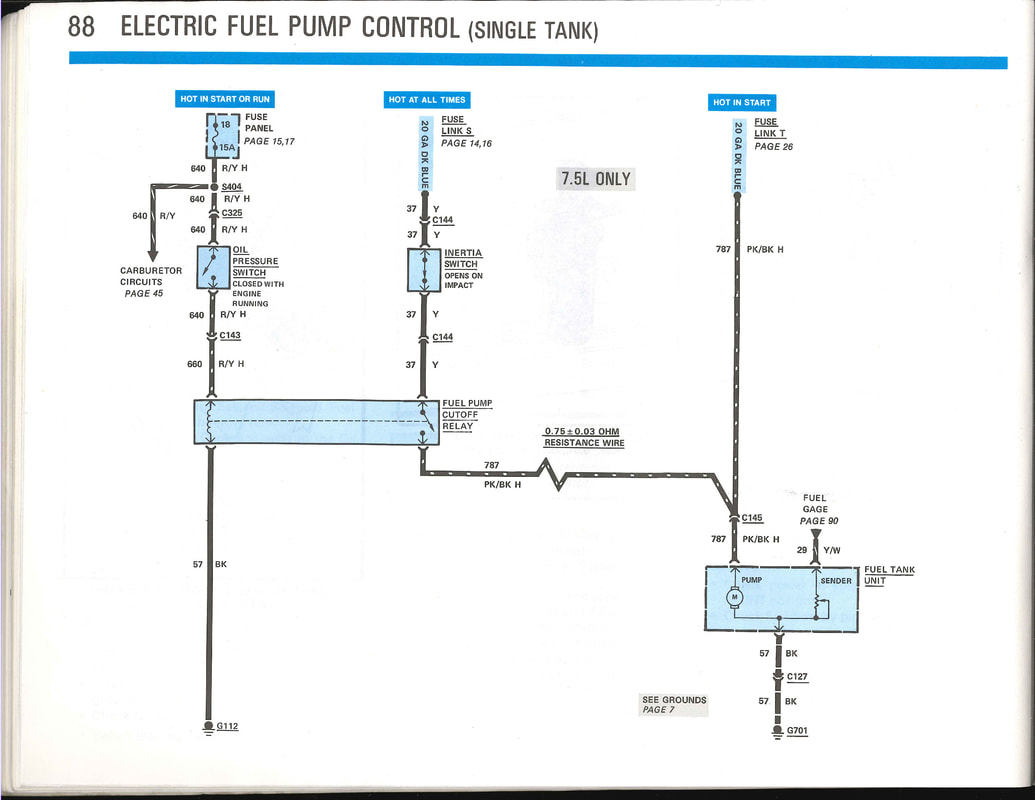
Gary, AKA "Gary fellow": Profile
Dad's: '81 F150 Ranger XLT 4x4: Down for restomod: Full-roller "stroked 351M" w/Trick Flow heads & intake, EEC-V SEFI/E4OD/3.50 gears w/Kevlar clutches
|
|
Thank you for the info. Looks like I have some testing to do.
Jeff,
I like trucks. I really like Ford trucks, Old Blue 1986 F250 460 4x4 standard, Polar Bear 1992 F250 460 4x4 Auto, Blackie 2001 F150 5.4 4x4 Auto and a Chevy Named White Truck 1979 C30 454 standard. What did I do with that wench I just had it! |
|
Administrator
|
In reply to this post by Gary Lewis
I asked Scott about this the other day when he posted about how he wired his fuse panel so that one position was reduced while cranking.
The pump power is reduced in 'run' because it helps keep the pump from overheating and circulating too much fuel. Once again I'm going to say backfiring is not a fuel problem. It is a symptom of spark while the valve(s) are open, or it is a problem of intermittent ignition allowing raw fuel into the exhaust, and then igniting it. But if it is popping out the carb, then it is bad cam timing, because you couldn't advance the distributor enough to ignite the mixture before the intake closed. And if your 4180 has been subjected to a true backfire (out the carb) then the Powervalve is likely ruptured. Which will be a fuel problem, but is a symptom, not a cause. Edit: the only other thing I see causing poor running and backfire is using the wrong firing order. But describe exactly what is happening, or better yet post a video so we can all see. Holley didn't incorporate a check ball to protect from that until 1991.
Jim,
Lil'Red is a '87 F250 HD, 4.10's, 1356 4x4, Zf-5, 3G, PMGR, Saginaw PS, desmogged with a Holley 80508 and Performer intake. Too much other stuff to mention. |
|
Thank you Jim,
I understand and agree. I can't take a video right now I have the steering column dropped. I'm fixing an old problem where the ignition switch failed and I bypassed it with a push button to start. It ran that way for a few years. I tested the switch and it is bad. (Broken Start pin) I'm replacing it today. This is the ignition switch, not the Key cylinder switch. I don't know if this will change anything on the back firing issue. I just wanted to have everything back to how it was originally. I have checked the firing order. It's correct When I rebuilt the carburetor I put in the check ball kit to protect the power valve. Here's exactly what it was doing with the push button start. Pump the gas start the engine. Choke is closed. Engine running no backfire in exhaust. Gas pressure at 2PSI. As engine warms choke slowly opens. Engine idles fine for a bit then starts back firing. Engine starts to die. Still at 2PSI. I pull off the Blue wire (Fuse link with the Diode) that goes to (I) on the starter relay. This wire is +12 only when the engine is running. Engine running and back firing still at 2PSI. I jump the blue wire (that is +12) directly to +12 on the battery. Gas pressure increases to 3 psi engine stops back firing and runs fine. I have not yet tested the diode on the blue wire. After I put in the new switch I'll video it. Thank you!
Jeff,
I like trucks. I really like Ford trucks, Old Blue 1986 F250 460 4x4 standard, Polar Bear 1992 F250 460 4x4 Auto, Blackie 2001 F150 5.4 4x4 Auto and a Chevy Named White Truck 1979 C30 454 standard. What did I do with that wench I just had it! |
|
Administrator
|
This post was updated on .
The fuselink (T) to the relay 'I' pin only gets power while the starter is engaged.
This is what gives power to prime the pumps before the engine builds enough oil pressure to close the pump relay. Fuselink (S) which feeds the pumps is hot at all times and goes to the inertia switch. From there to the fuel pump relay, which gets pulled closed when you have oil pressure. Both of the above then go to the selector switch. If your ignition switch is randomly cutting out of course the exhaust will load with gas, and likely bike the muffler apart. So maybe replacing the defective switch and eliminating the push button will fix that problem. Let's have a look at the EVTM.
Jim,
Lil'Red is a '87 F250 HD, 4.10's, 1356 4x4, Zf-5, 3G, PMGR, Saginaw PS, desmogged with a Holley 80508 and Performer intake. Too much other stuff to mention. |
|
Administrator
|
This post was updated on .
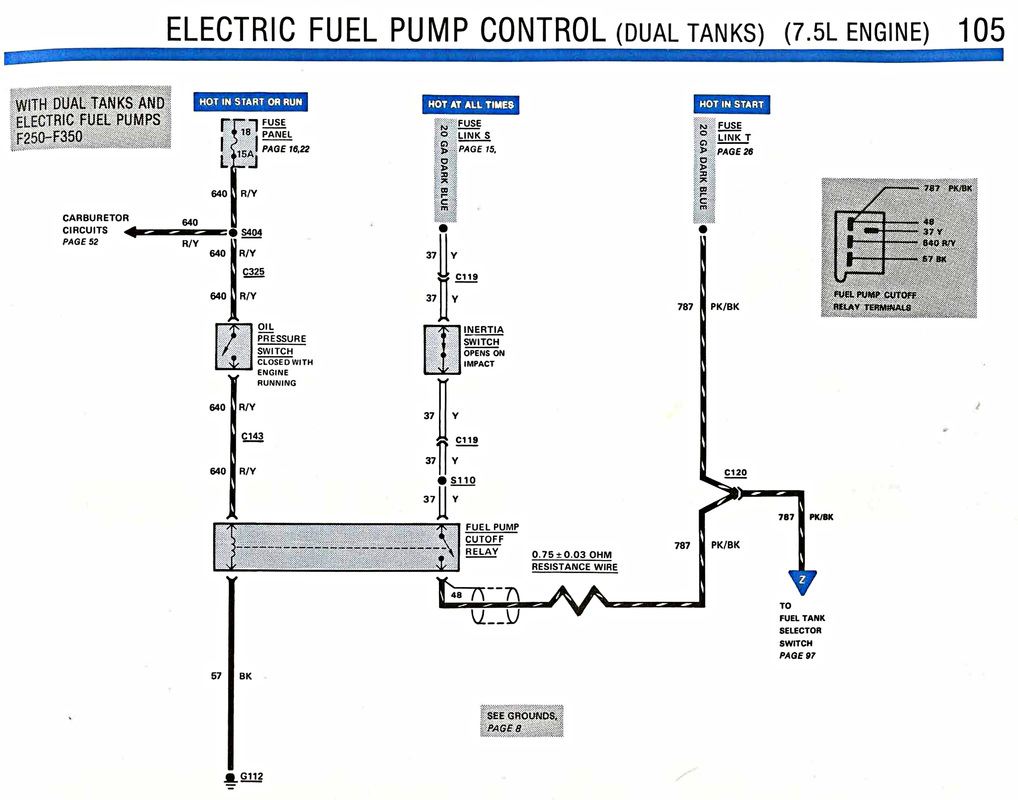 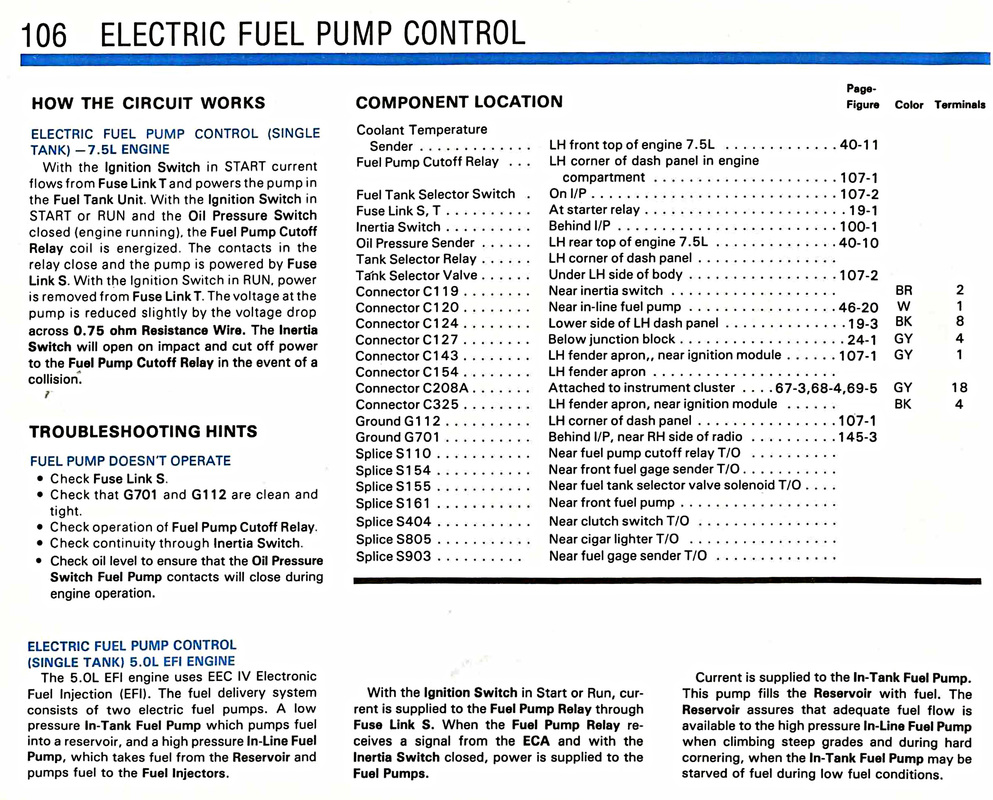 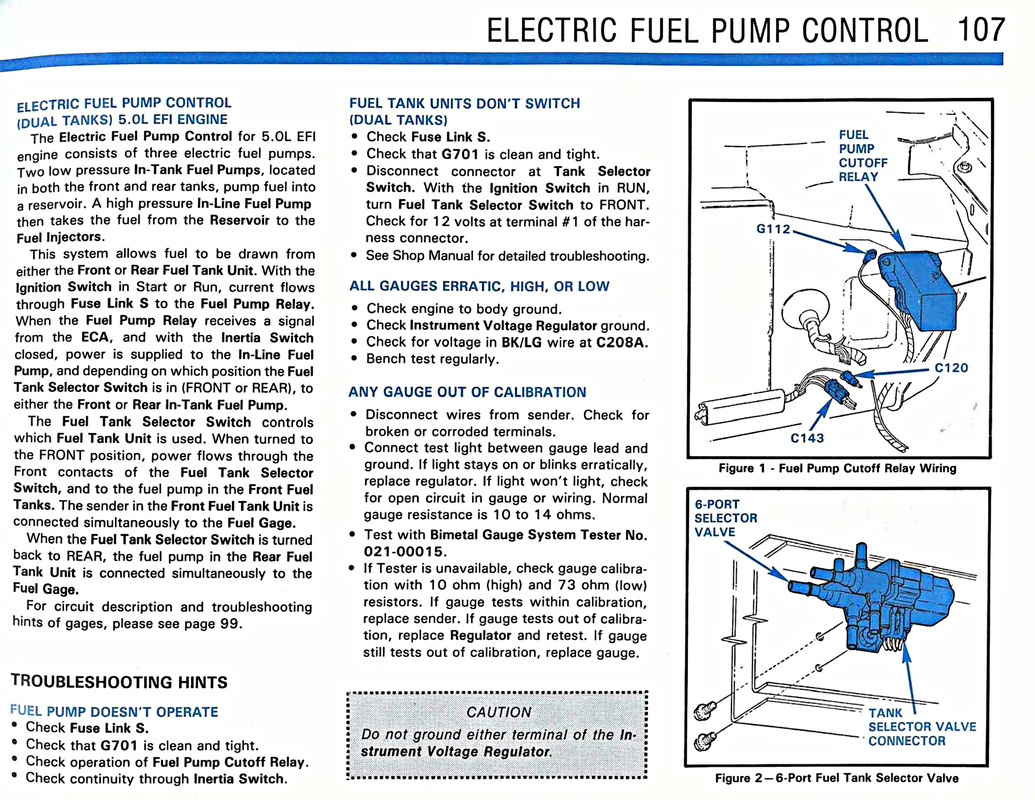 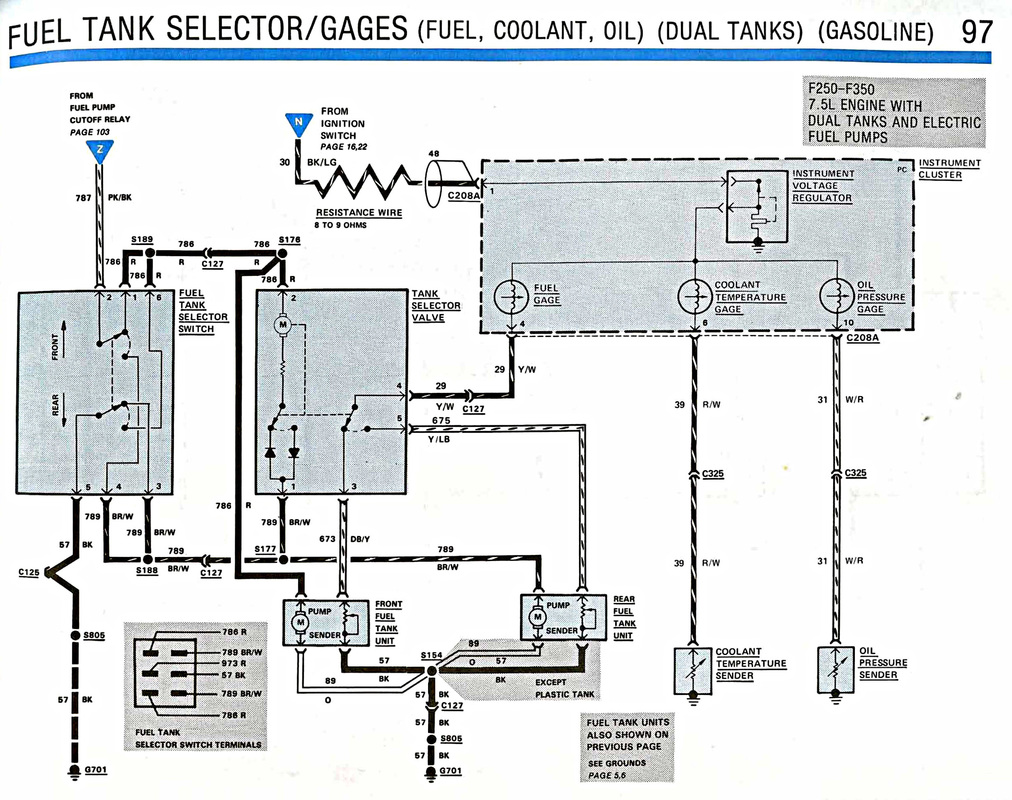 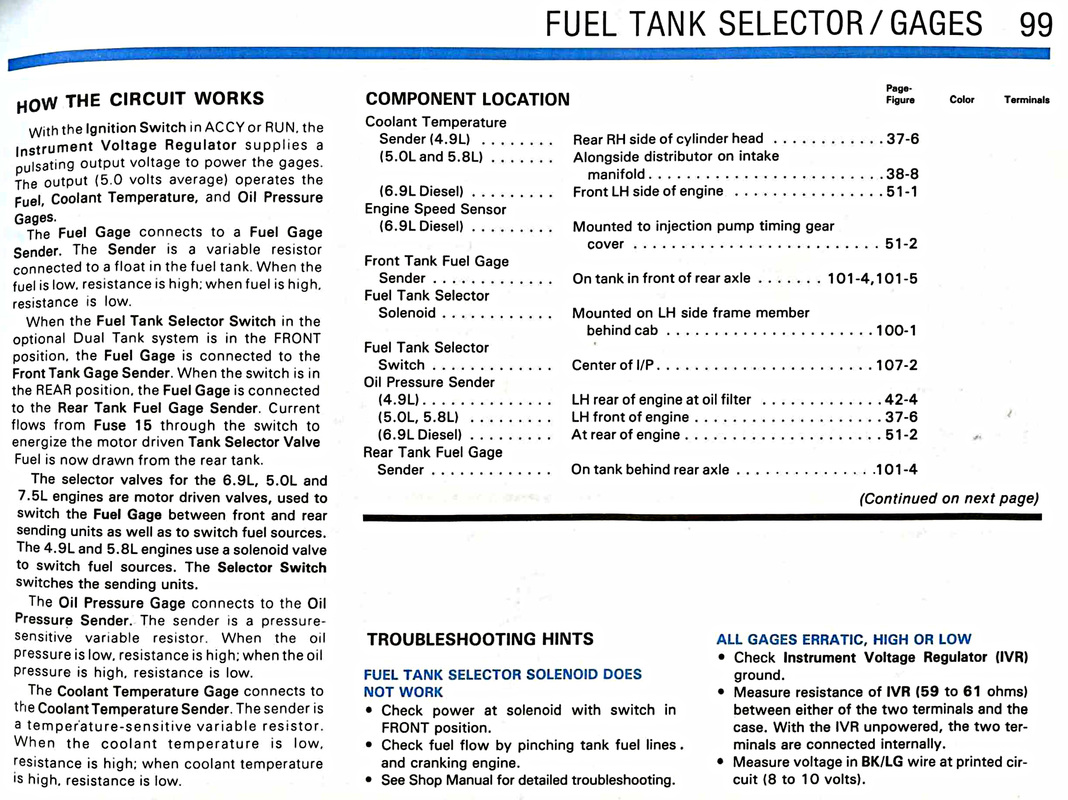 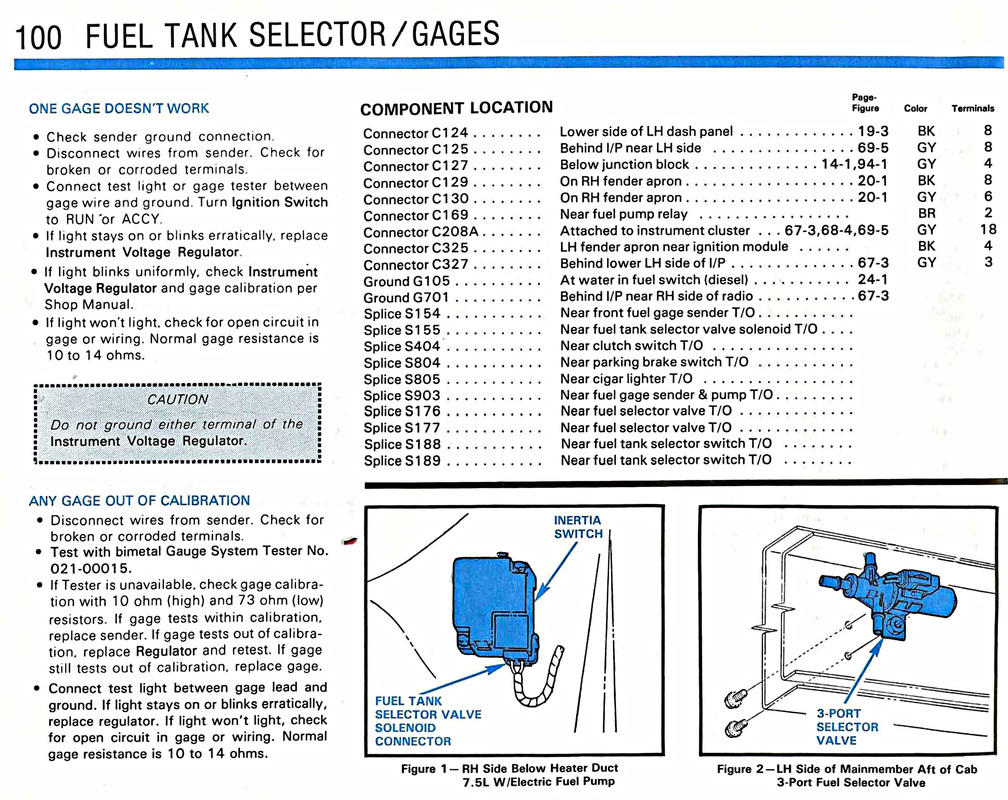 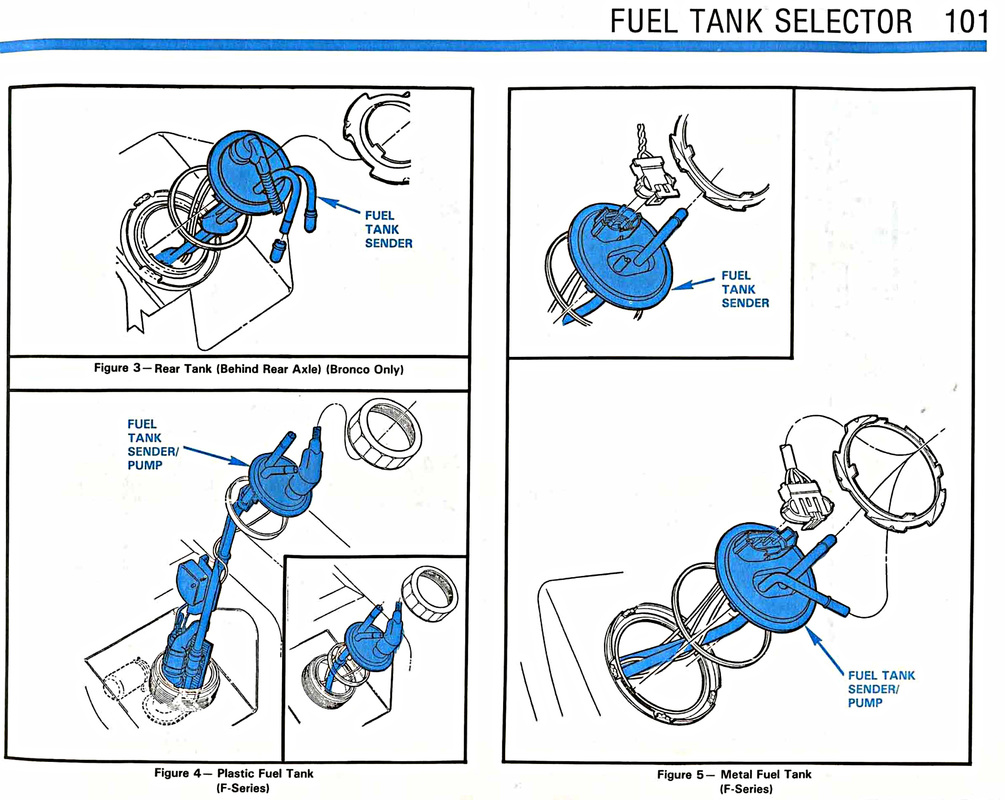
Jim,
Lil'Red is a '87 F250 HD, 4.10's, 1356 4x4, Zf-5, 3G, PMGR, Saginaw PS, desmogged with a Holley 80508 and Performer intake. Too much other stuff to mention. |
|
Thanks Jim,
Looks like I'll be testing relays and wiring. I do have +12 on line T constantly when the engine is running. I'm calling it a day it's getting to cold. Jeff
Jeff,
I like trucks. I really like Ford trucks, Old Blue 1986 F250 460 4x4 standard, Polar Bear 1992 F250 460 4x4 Auto, Blackie 2001 F150 5.4 4x4 Auto and a Chevy Named White Truck 1979 C30 454 standard. What did I do with that wench I just had it! |
|
Administrator
|
You should have battery voltage on T only when the starter is engaged.
You should have battery voltage on line S at all times (even with the key out) I can't say what previous owners have done, but the diagrams above are pretty simple to follow. 
Jim,
Lil'Red is a '87 F250 HD, 4.10's, 1356 4x4, Zf-5, 3G, PMGR, Saginaw PS, desmogged with a Holley 80508 and Performer intake. Too much other stuff to mention. |
|
Just my 2 cents, but looking at the wiring diagram you will have 12v at T when the engine is running because it will backfeed from the fuel pump that is powered from the energized fuel pump relay.
Bob near Winnipeg
1986 F250 Lariat extended cab 300 T18 2WD 1979 Honda CX500 1992 Oldsmobile 98 touring sedan 2007 F250 6.0 4wd |
|
Administrator
|
I don't understand why the EVTM is not showing the diode mentioned.
I know it is there...
Jim,
Lil'Red is a '87 F250 HD, 4.10's, 1356 4x4, Zf-5, 3G, PMGR, Saginaw PS, desmogged with a Holley 80508 and Performer intake. Too much other stuff to mention. |
|
Administrator
|
There will be a voltage at T with the engine running, but it should be lower than 12V due to the resistance wire and the current load of the fuel pump. If the pump is not in the circuit due to failure or an open circuit, than you will show 12V. If you don't believe it, try this at the coil. Key on, engine off, unplug the "horseshoe" and measure the voltage on the + side, it will be 12V, plug it in and see what it reads, it will be closer to 6V.
Since the wiring has been intercoursed with, I would see if the resistance wire is even there. The value is given in the EVTM. On a side note, I just found I still have the engine part of the fuel pump wiring.
Bill AKA "LOBO" Profile
"Getting old is inevitable, growing up is optional" Darth Vader 1986 F350 460 converted to MAF/SEFI, E4OD 12X3 1/2 rear brakes, traction loc 3:55 gear, 160 amp 3G alternator Wife's 2011 Flex Limited Daily Driver 2009 Flex Limited with factory tow package Project car 1986 Chrysler LeBaron convertible 2.2L Turbo II, modified A413 |
|
Jim, I had not copied that the diode was in the circuit, I should have read your earlier posts more carefully. As for the voltage that is present at the pump, I could be wrong but I think the main function of the resistor, .75 ohm, is to compensate for the difference in system voltage between a cranking and a running engine. A low pressure fuel pump shouldn't be drawing more than 3 - 4 amps and so with a running engine the pump should see ~ 14 - (~ 2.5 resistor drop) = ~ 11.5v.
Flashbacks through the carb brings back memories of singed eyebrows trying to clear flooded cammed big blocks. Quickly learn to keep the head back as one holds the choke open. Bob
Bob near Winnipeg
1986 F250 Lariat extended cab 300 T18 2WD 1979 Honda CX500 1992 Oldsmobile 98 touring sedan 2007 F250 6.0 4wd |
|
Administrator
|
I can't get the Daffy Duck exploding cigar out of my head now!

Jim,
Lil'Red is a '87 F250 HD, 4.10's, 1356 4x4, Zf-5, 3G, PMGR, Saginaw PS, desmogged with a Holley 80508 and Performer intake. Too much other stuff to mention. |
|
Thank you all for the input. I now have Daffy Duck and the old exploding cigar in my head

I'm not sure where this diode would be unless it's in the tank selector relay? To answer Bill The .75 ohm resistance wire is there and measured fine, and I can here the pump run. Jeff
Jeff,
I like trucks. I really like Ford trucks, Old Blue 1986 F250 460 4x4 standard, Polar Bear 1992 F250 460 4x4 Auto, Blackie 2001 F150 5.4 4x4 Auto and a Chevy Named White Truck 1979 C30 454 standard. What did I do with that wench I just had it! |
|
Administrator
|
Now all you need is Wile E Coyote chasing the roadrunner....
The only diodes I see in that diagram are the two in the tank selector valve as part of the motor feed circuit.
Bill AKA "LOBO" Profile
"Getting old is inevitable, growing up is optional" Darth Vader 1986 F350 460 converted to MAF/SEFI, E4OD 12X3 1/2 rear brakes, traction loc 3:55 gear, 160 amp 3G alternator Wife's 2011 Flex Limited Daily Driver 2009 Flex Limited with factory tow package Project car 1986 Chrysler LeBaron convertible 2.2L Turbo II, modified A413 |
|
Administrator
|
You are right Bill!
I is isolated from the starter when the relay is disengaged. I guess there's no reason to keep it from back feeding.
Jim,
Lil'Red is a '87 F250 HD, 4.10's, 1356 4x4, Zf-5, 3G, PMGR, Saginaw PS, desmogged with a Holley 80508 and Performer intake. Too much other stuff to mention. |
|
ok, but after all this, you're still not getting 4.3 psi to the carb,,, why??
|
| Edit this page |

